by Bruce Wells | Apr 29, 2024 | Energy Education Resources
Petroleum geologists helped create the Boy Scouts of America geology merit badge in 1953.
The Boy Scouts of America’s geology merit badge began in 1911 as a mining badge — one of less than 30 scouting badges. The mining merit badge in 1937 changed to rocks and minerals before becoming the geology badge in 1953.
The story behind the geology merit badge is best told by a member of the Houston Geological Society (HGS), a resource for potential badge earners.

Petroleum geologists helped inspire the Geology merit badge adopted in 1953.
Petroleum geologist Jeff Spencer, himself an Eagle Scout, has published dozens of petroleum history papers and frequently contributed to Oil-Industry History, the peer-reviewed journal of the Petroleum History Institute (PHI), Oil City, Pennsylvania.
According to Spencer, the original Boy Scouts mining merit badge had several basic requirements, including naming at least 50 minerals; describing the 14 great divisions of the earth’s crust; and defining terms like watershed, delta, drift, fault, glacier, terrace and stratum.

Scouts seeking the mining badge also were asked to identify 10 different kinds of rock and describe methods for mine ventilation and safety devices,

Scouts earned the Rocks & Minerals badge from 1937 until 1953.
The first mention of oil and natural gas appeared in 1927 — the mining badge requirement asked Scouts to “explain how we locate petroleum and natural gas pools, and how we obtain oil and gas,” Spencer notes.
In September 1937, the mining merit badge (a shovel) was replaced with the rocks and minerals badge (a crystal). The first merit badge booklet was published the same year by Daniel O ’Connell, chairman of the department of geology at the City College of New York.
O’Connell’s “Rocks and Minerals” booklet would go through through many revised printings in the next ten years, according to the Geological Society of America (GSA).

The first 12 merit badges of the Boy Scouts of America, which encourages visits to science museums and geology departments of local universities.
In 2014, thanks in part to the Society for Mining and Metallurgy (SME), the mining merit badge returned as “Mining and Society.”
Petroleum Geologists
In 1945, the American Association of Petroleum Geologists (AAPG) formed a “Committee on Boy Scout Literature” at the urging of industry leaders, including A.C. Bace, a geologist with Stanolind, and George W. Pirtlem, an independent geologist from Tyler, Texas.
Oklahoma geologist Frank Gouin chaired the AAPG committee’s effort to revise the merit badge and its requirements, and the geology badge officially replaced the Rocks and Minerals badge in 1953.

Spencer notes that the 1953 merit badge’s description of what a geologist does said that four out of five geologists become “oil geologists” with an expected starting salary of $300 per month.
“You may have to be a nomad instead of settling down for life in one spot,” the description continued. “You may have to ‘sit on’ a well all night and then drive a hundred miles to report on it. You may have to burn in India, freeze in Alaska, or do both in the Texas Panhandle.”
Although minor revisions of the geology merit badge occurred in 1957, the next major change came in 1982, adding anticlines, synclines, and faults with a requirement to draw simple diagrams showing unconformity, strikes and dips.
The last major revision of the geology badge occurred in 1985, Spencer says, again with the cooperation of AAPG leadership. The badge now has 13 requirements, organized under five categories: earth materials, earth processes, earth history, geology and people, and careers in geology.
- The earth materials section includes the collection and identification of rocks and minerals.
- The earth processes section covers geomorphology, the hydrologic cycle, volcanoes, mountain building, and the ocean floor.
- The earth history section includes the geologic time chart, fossils, and continental drift. The geology and people section covers environmental geology and energy sources with a field trip option in this category.
In addition to its involvement in merit badges, AAPG and its chapters serve the scouting program in many ways, Spencer concludes. The Houston Geological Society has sponsored “Explorer Posts” and worked with the Houston Museum of Natural Science to teach the elements of earning the badge.

OPEC-inspired energy badge.
There now are more than 120 merit badges. The OPEC oil embargo of 1973 — and the need for energy conservation — led to creation of an energy merit badge in 1977.

In 2013, Jeff Spencer published a selection of oil patch post cards via Arcadia Publishing’s postcard history series. Texas Oil and Gas includes more than 200 vintage black-and-white images through decades of oil booms throughout the state.
Chapters reflect the Lone Star State’s petroleum heritage by region, including “Spindletop and the Golden Triangle,” a prolific area in southeast Texas between Beaumont, Port Arthur and Orange (read more about Spencer’s Texas oil postcards).
_______________________
Recommended Reading: Texas Oil and Gas, Postcard History (2013); Trek of the Oil Finders: A History of Exploration for Petroleum (1975); Anomalies: Pioneering Women in Petroleum Geology 1917-2017 (2017). Your Amazon purchase benefits the American Oil & Gas Historical Society. As an Amazon Associate, AOGHS earns a commission from qualifying purchases.
(2013); Trek of the Oil Finders: A History of Exploration for Petroleum (1975); Anomalies: Pioneering Women in Petroleum Geology 1917-2017 (2017). Your Amazon purchase benefits the American Oil & Gas Historical Society. As an Amazon Associate, AOGHS earns a commission from qualifying purchases.
_______________________
The American Oil & Gas Historical Society (AOGHS) preserves U.S. petroleum history. Please become an AOGHS annual supporter and help maintain this energy education website and expand historical research. For more information, contact bawells@aoghs.org. Copyright © 2024 Bruce A. Wells. All rights reserved.
Citation Information: Article Title – “Merit Badge for Geology.” Authors: Aoghs.org Editors. Website Name: American Oil & Gas Historical Society. URL: https://aoghs.org/energy-education-resources/geology-merit-badge. Last Updated: May 1, 2024. Original Published Date: June 1, 2008.
by Bruce Wells | Feb 5, 2024 | This Week in Petroleum History
February 5, 1873 – Death of an Illegal Oil Well Shooter –
Andrew Dalrymple, allegedly a frequent “moonlight oil well shooter” in the Tidioute, Pennsylvania, region, was killed in a nitroglycerin explosion at his home on Dennis Run, the Titusville Morning Herald reported. Supplies of nitroglycerin lately had been stolen from magazines throughout the oil region by those seeking to avoid fees for using the Roberts torpedo. “This species of theft is winked at by some parties, who are opposed to the Roberts torpedo patent,” the newspaper noted.
February 5, 1998 – DOE privatizes Elk Hills Petroleum Reserve
The Department of Energy and Occidental Petroleum concluded the largest divestiture of federal property in U.S. history with the sale of Elk Hills Naval Petroleum Reserve in Kern County, California. As the highest corporate bidder, Occidental ended the government’s business operations of oil and natural gas production at the 75-square-mile reserve. The $3.65 billion DOE divestment completed a privatization process that had begun years earlier.

The California Resources Corporation (CRC) in 2018 acquired the former Naval Petroleum Reserve No. 1 in Kern County. California. Map courtesy Wikimedia Commons.
The Clinton Administration in May 1995 had proposed placing the federally-owned Elk Hills reserve on the market in an effort “to reduce the size of government and return inherently non-federal functions to the private sector,” according to the DOE Office of Fossil Energy.
Discovered in 1911 and designated America’s first oil preserve one year later, Elk Hills returned to production following the 1973 oil crisis, becoming one of the top ten most productive U.S. fields. The former Naval Petroleum Reserve No. 1 — made famous by the 1922 “Teapot Dome Scandal” during the Harding administration — was acquired by California Resources Corporation (CRC) in 2018.

February 7, 1817 – First Gas Street Light
Fueled by manufactured gas (distilled from tar and wood), America’s first public street lamp illuminated Market Street in Baltimore, making Gas Light Company of Baltimore the first U.S. commercial gas lighting company. City officials erected a replica of the lamp in 1997.
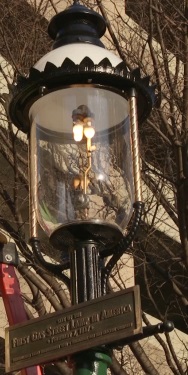
The first U.S. gas street lamp illuminated Baltimore in 1817. Photo courtesy BG&E.
Artist Rembrandt Peale earlier had demonstrated the brightness of manufactured gas with a “ring beset with gems of light” at his Baltimore museum. “During a candlelit period in American history, the forward-thinking Peale aimed to form a business around his gas light innovations, and the exhibition targeting potential investors,” notes Baltimore Gas & Electric (BG&E), which began as the Gas Light Company of Baltimore.
Learn more in Illuminating Gaslight.
February 8, 1836 – Coal Gas brightens Philadelphia
As Philadelphia became America’s center for finance and industry, a municipally owned gas distribution company began lighting Second Street. The newly formed Philadelphia Gas Works ignited 46 lamps that burned manufactured coal gas. In Washington, D.C, manufactured gas began replacing kerosene lamps in the U.S. Capitol by 1847.
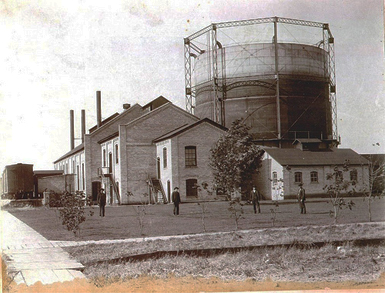
A manufactured gas storage facility at Point Breeze in South Philadelphia, circa 1856. Photograph courtesy Philadelphia Gas Works.
Philadelphia Gas Works in 1856 completed construction of a manufactured gas storage tank with a total capacity of 1.8 million cubic feet, the largest in America at the time. The village of Fredonia, New York, began the first commercial use of natural gas as early as 1825.
February 9, 2013 – Curiosity drills on Mars
Images transmitted from NASA’s robotic rover Curiosity confirmed it successfully drilled on the Martian surface, accomplishing “history’s first ever drilling and sampling into a pristine alien rock on the surface of another planet in our solar system,” according to Universe Today.
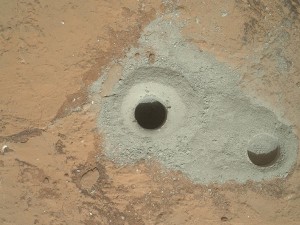
Mars rover Curiosity tested its rotary-percussion bit by making a shallow hole before drilling the first well on another planet. Photo courtesy NASA/JPL.
While exploring the Red Planet’s Yellowknife Bay Basin, Curiosity paused to drill for the first time, making a hole .63 inches wide and 2.5 inches deep. A rotary-percussion drill bit at the end of a seven-foot robotic arm penetrated a “red slab of fine-grained sedimentary rock with hydrated mineral veins of calcium sulfate.”

Curiosity’s “rotary-percussion” bit measured .6 of an inch wide. Photo courtesy NASA/JPL.
Images beamed from the site included a drill test next to the historic borehole. After completing Mars No. 1 (unofficial name), the one-ton rover drilled many others using its slow, “low-percussion” technique. Learn about terrestrial drilling methods in Making Hole – Drilling Technology.
February 10, 1910 – Giant Oilfield discovered in California
Honolulu Oil Corporation discovered the Buena Vista oilfield in Kern County, California. The well, originally known as “Honolulu’s great gasser,” was drilled further into deeper oil-producing sands, and initial production averaged 3,500 barrels of oil a day. Steam injection operations helped the field produce “heavy” (high viscosity) oil from depths of about 4,000 feet.
In 1912, as the Navy began converting its warship boilers from coal to oil (see Petroleum & Sea Power), the San Joaquin Valley oilfield was designated Naval Petroleum Reserve No. 2. In 2000, the Department of Energy leased 90 percent of the 30,000-acre Buena Vista reserves to private oil companies.

February 10, 1917 – Petroleum Geologists get Organized in Tulsa
About 90 geologists gathered in Oklahoma to form an association where “only reputable and recognized petroleum geologists are admitted.” They met at Henry Kendall College, now Tulsa University, to establish the Southwestern Association of Petroleum Geologists, today’s American Association of Petroleum Geologists (AAPG).
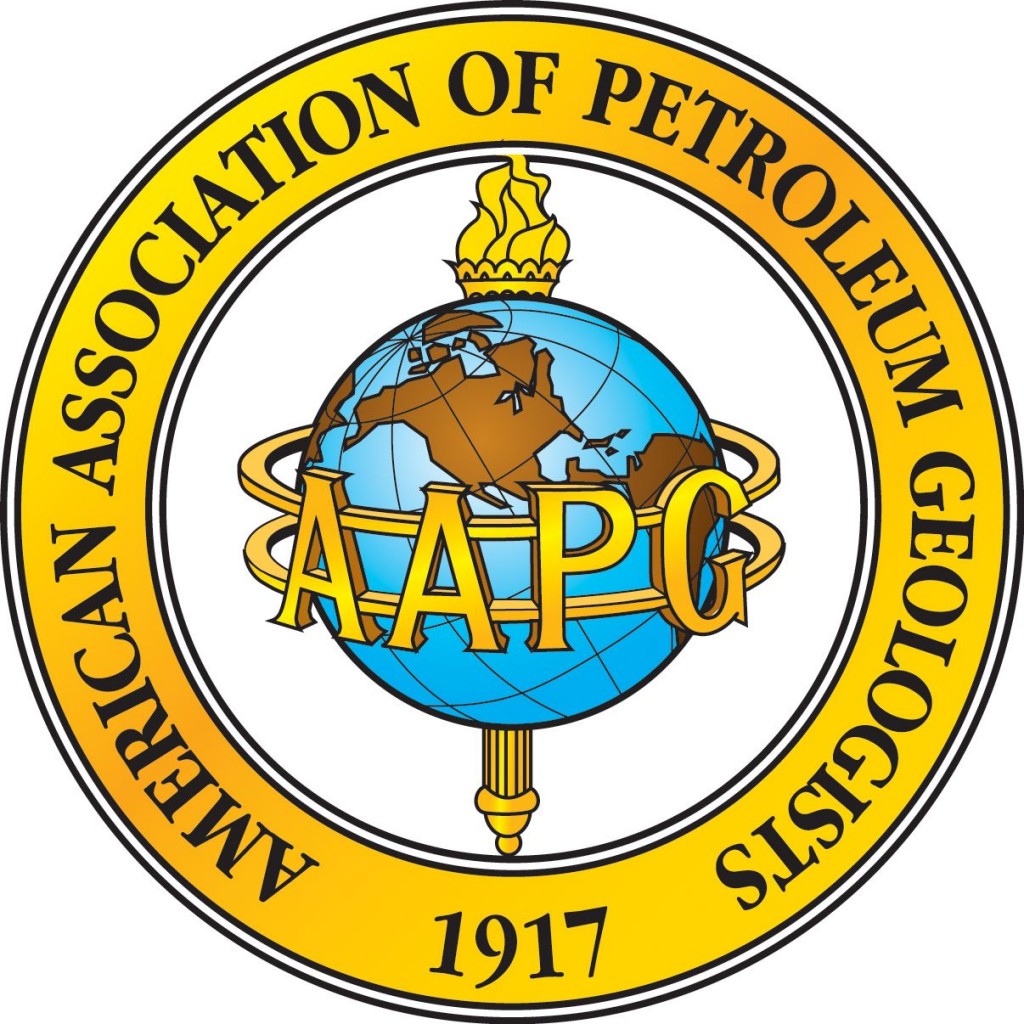
Petroleum geologists celebrated the AAPG centennial in 2017.
Adopting its current name in 1918, AAPG also launched its peer-reviewed scientific journal, the Bulletin. By 1920, industry trade magazines were praising the association’s professionalism and success combating, “unscrupulous and inadequately prepared men who are attempting to do geological work.”
AAPG in 1945 formed a committee to assist the Boy Scouts of America with a geology merit badge. The association’s membership has grown to almost 40,000 members in more than 100 countries.
Learn more in AAPG – Geology Pros since 1917.
February 10, 1956 – Frank Lloyd Wright’s Only Skyscraper
Harold C. Price Sr., founder of the pipeline construction company H.C. Price, dedicated his headquarters building in Bartlesville, Oklahoma. The 19-story concrete and copper office tower remains the only skyscraper designed by architect Frank Lloyd Wright. Wright also designed the Price family residence in Arizona, completed in 1955.
Established in 1921, H.C. Price specialized in field welding oil storage tanks and electric welding of pipelines. The company helped construct the “Big Inch” pipelines during WWII and built large sections of the 800-mile Trans-Alaska Pipeline.

Designed by Frank Lloyd Wright, the Price Tower is listed on the National Register of Historic Places. Photo by Bruce Wells.
Wright designed the Bartlesville “Prairie Skyscraper” in four quadrants, “based on the geometry of a 30-60-90 degree double parallelogram module” with one quadrant for apartments and three for offices, according the current occupant, Price Tower Arts Center. The former H.C. Price Company headquarters at Dewey Avenue and Sixth Street was listed in the National Register of Historic Places in 1974.
_______________________
Recommended Reading: Around Titusville, Pennsylvania, Images of America (2004); Black Gold in California: The Story of California Petroleum Industry
(2004); Black Gold in California: The Story of California Petroleum Industry  (2016); In Pursuit of Fame: Rembrandt Peale, 1778-1860 (1993); Mars Rover Curiosity: An Inside Account from Curiosity’s Chief Engineer
(2016); In Pursuit of Fame: Rembrandt Peale, 1778-1860 (1993); Mars Rover Curiosity: An Inside Account from Curiosity’s Chief Engineer (2017); Trek of the Oil Finders: A History of Exploration for Petroleum (1975); Building Bartlesville, 1945-2000, Images of America: Oklahoma
(2017); Trek of the Oil Finders: A History of Exploration for Petroleum (1975); Building Bartlesville, 1945-2000, Images of America: Oklahoma (2008). Your Amazon purchase benefits the American Oil & Gas Historical Society. As an Amazon Associate, AOGHS earns a commission from qualifying purchases.
(2008). Your Amazon purchase benefits the American Oil & Gas Historical Society. As an Amazon Associate, AOGHS earns a commission from qualifying purchases.
_______________________
The American Oil & Gas Historical Society (AOGHS) preserves U.S. petroleum history. Become an AOGHS annual supporting member and help maintain this energy education website and expand historical research. For more information, contact bawells@aoghs.org. Copyright © 2024 Bruce A. Wells. All rights reserved.
by Bruce Wells | Feb 1, 2024 | Energy Education Resources
Growing oil demand challenged petroleum geologists, who organized a professional association.
As demand for petroleum grew during World War I, the science for finding oil and natural gas reserves remained obscure when a small group of geologists in 1917 organized what became the American Association of Petroleum Geologists (AAPG).
AAPG began as the Southwestern Association of Petroleum Geologists in Tulsa, Oklahoma, after about 90 geologists gathered at Henry Kendall College, now Tulsa University. They formed an association of earth scientists on February 10, 1917, “to which only reputable and recognized petroleum geologists are admitted.”

AAPG members maintain a professional business code.
Rapidly multiplying mechanized technologies of the “Great War” brought desperation to finding and producing vast supplies of oil. America entered the First War I two months after AAPG’s founding. An October 1917 giant oilfield discovery at Ranger, Texas, inspired a British War Cabinet member to declare, “The Allied cause floated to victory upon a wave of oil.”
Rock Hounds
In January 1918, the AAPG convention of in Oklahoma City reported 167 active members and 17 associate members. After adopting its present name one year after organizing at Henry Kendall College, the group issued its first technical bulletin, using papers and presentations delivered at the 1917 Tulsa meeting.

The professional “rock hounds” produced a mission statement that included promoting the science of geology, especially relating to oil and natural gas. The geologists also committed to encouraging “technology improvements in the methods of exploring for and exploiting these substances.”
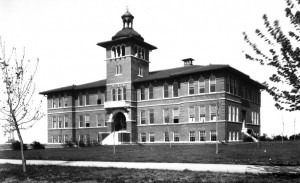
AAPG was founded in Tulsa, Oklahoma, at Henry Kendall College — today’s Tulsa University.
AAPG also began publishing a bimonthly journal that remains among the most respected in the industry. The peer-reviewed Bulletin included papers written by leading geologists of the day.
With a subscription price of five dollars, the journal was distributed to members, university libraries, and other industry professionals.
Finding Faults and Anticlines
By 1920, one petroleum trade magazine — after complaining of the industry’s lack of skilled geologists — noted the “Association Grows in Membership and Influence; Combats the Fakers.”
The article praised AAPG professionalism and warned of “the large number of unscrupulous and inadequately prepared men who are attempting to do geological work.”
Similarly, the Oil Trade Journal praised AAPG for its commitment “to censor the great mass of inadequately prepared and sometimes unscrupulous reports on geological problems, which are wholly misleading to the industry.”

Perhaps the best known such fabrication is related to the men behind the 1930 East Texas oilfield discovery — a report entitled “Geological, Topographical And Petroliferous Survey, Portion of Rusk County, Texas, Made for C.M. Joiner by A.D. Lloyd, Geologist And Petroleum Engineer.”
Using very scientific terminology, A.D. Lloyd’s document described Rusk County geology — its anticlines, faults, and a salt dome — all features associated with substantial oil deposits…and all completely fictitious.
The fabrications nevertheless attracted investors, allowing Joiner and “Doc” Lloyd to drill a well that uncovered a massive oil field, still the largest conventional oil reservoir in the lower-48 states.
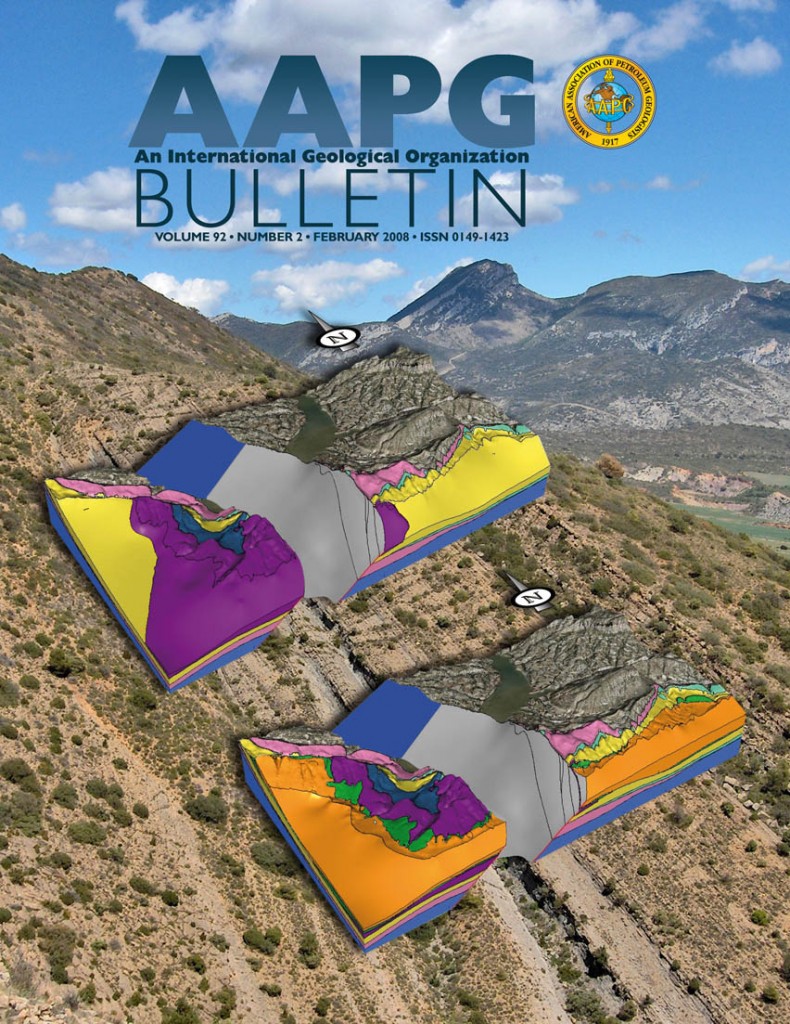
AAPG’s peer-reviewed journal first appeared in 1918, one year after the association’s first meeting in Tulsa.
Equally imaginative science came from Lloyd’s earlier descriptions of the “Yegua and Cook Mountain” formations and the thousands of seismographic registrations he ostensibly recorded. Lloyd, a former patent medicine salesman, and other self-proclaimed geologists, were the antithesis of the AAPG professional ethic.
In 1945, AAPG formed a “Committee on Boy Scout Literature” to assist the Boy Scouts of America in updating requirements for the “mining” badge, which had been awarded since 1911 (learn more in Merit Badge for Geology).

By 1953, AAPG membership had grown to more than 10,000 and a permanent headquarters building opened Tulsa. The association’s 2022 membership included about 40,000 members in 129 countries in the upstream energy industry, “who collaborate — and compete — to provide the means for humankind to thrive.”
The world’s largest professional geological society, a nonprofit organization, maintains a membership code to assure “integrity, business ethics, personal honor, and professional conduct.”
Oil Patch Historians
Longtime AAPG member Ray Sorenson, a Tulsa-based consulting geologist, has made numerous presentations about the history of petroleum. After publishing papers in leading academic journals, he adapted many of his contributions for the association’s 2007 Discovery Series, “First Impressions: Petroleum Geology at the Dawn of the North American Oil Industry.”
Further, Sorenson continued to research and collect a vast amount of material documenting the earliest signs of oil — worldwide references to hydrocarbons earlier that the 1859 first U.S. oil well drilled by Edwin Drake in Pennsylvania.
Drake expert and geologist and historian William Brice, professor emeritus at the University of Pittsburgh at Johnstown, in 2009 published Myth, Legend, Reality – Edwin Laurentine Drake and the Early Oil Industry. His 661-page epic was researched and written as part of the U.S. petroleum industry’s 150th anniversary (learn more in Edwin Drake and his Oil Well),
As part if AAPG’s 2017 centennial events, geologist Robbie Rice Gries published Anomalies: Pioneering Women in Petroleum Geology 1917-2017. Researched with help from AAPG volunteers, her 405-page book includes contributors’ personal stories, written correspondence, and photographs dating back to the early 1900s.

The stories in Gries’ book should be read by every petroleum geologist, geophysicist and petroleum engineer, according to independent producer Marlan Downey, founder of Roxanna Oil Company. “Partly for the pleasure of the sprightly told adventures, partly for a sense of history, and, significantly, because it engenders a proper respect towards all women professionals, forging their unique way in a ‘man’s world.’”
_______________________
Recommended Reading: Anomalies: Pioneering Women in Petroleum Geology 1917-2017 (2017); Trek of the Oil Finders: A History of Exploration for Petroleum (1975); Myth, Legend, Reality – Edwin Laurentine Drake and the Early Oil Industry (2009); The Prize: The Epic Quest for Oil, Money & Power (1991); The Birth of the Oil Industry (1936). Your Amazon purchase benefits the American Oil & Gas Historical Society. As an Amazon Associate, AOGHS earns a commission from qualifying purchases.
(2009); The Prize: The Epic Quest for Oil, Money & Power (1991); The Birth of the Oil Industry (1936). Your Amazon purchase benefits the American Oil & Gas Historical Society. As an Amazon Associate, AOGHS earns a commission from qualifying purchases.
_______________________
The American Oil & Gas Historical Society preserves U.S. petroleum history. Become an AOGHS annual supporting member and help maintain this energy education website and expand historical research. For more information, contact bawells@aoghs.org. Copyright © 2024 Bruce A. Wells. All rights reserved.
Citation Information – Article Title: “AAPG – Geology Pros since 1917.” Authors: B.A. Wells and K.L. Wells. Website Name: American Oil & Gas Historical Society. URL:https://aoghs.org/energy-education-resources/aapg-geology-pros-since-1917. Last Updated: February 1, 2024. Original Published Date: April 29, 2014.




(2013); Trek of the Oil Finders: A History of Exploration for Petroleum (1975); Anomalies: Pioneering Women in Petroleum Geology 1917-2017 (2017). Your Amazon purchase benefits the American Oil & Gas Historical Society. As an Amazon Associate, AOGHS earns a commission from qualifying purchases.












